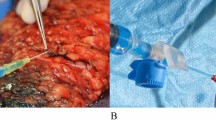Abstract
Pathological alterations of lymphatic structure and function interfere with lymph transport, resulting in a wide range of clinical disorders that include edema, tissue inflammation, and metabolic syndromes. Mesentery contains abundant lymphatic vessels and plays an important role in transporting absorbed lipid from the intestine. In this manuscript, we describe a whole-mount staining method on isolated mouse mesentery with VEGFR3, Prox1, and Lyve1 antibodies to visualize the morphology of lymphatic vessels.
Access this chapter
Tax calculation will be finalised at checkout
Purchases are for personal use only
Similar content being viewed by others
References
Semo J, Nicenboim J, Yaniv K (2016) Development of the lymphatic system: new questions and paradigms. Development 143(6):924–935
Oliver G (2004) Lymphatic vasculature development. Nat Rev Immunol 4(1):35–45
Zheng W, Aspelund A, Alitalo K (2014) Lymphangiogenic factors, mechanisms, and applications. J Clin Invest 124(3):878–887
Alitalo K, Tammela T, Petrova TV (2005) Lymphangiogenesis in development and human disease. Nature 438(7070):946–953
Mahadevan A, Welsh IC, Sivakumar A, Gludish DW, Shilvock AR, Noden DM et al (2014) The left-right Pitx2 pathway drives organ-specific arterial and lymphatic development in the intestine. Dev Cell 31(6):690–706
Sabine A, Agalarov Y, Maby-El Hajjami H, Jaquet M, Hagerling R, Pollmann C et al (2012) Mechanotransduction, PROX1, and FOXC2 cooperate to control connexin37 and calcineurin during lymphatic-valve formation. Dev Cell 22(2):430–445
Wigle JT, Oliver G (1999) Prox1 function is required for the development of the murine lymphatic system. Cell 98(6):769–778
Gale NW, Prevo R, Espinosa J, Ferguson DJ, Dominguez MG, Yancopoulos GD et al (2007) Normal lymphatic development and function in mice deficient for the lymphatic hyaluronan receptor LYVE-1. Mol Cell Biol 27(2):595–604
Luong MX, Tam J, Lin Q, Hagendoorn J, Moore KJ, Padera TP et al (2009) Lack of lymphatic vessel phenotype in LYVE-1/CD44 double knockout mice. J Cell Physiol 219(2):430–437
Zhang Y, Ulvmar MH, Stanczuk L, Martinez-Corral I, Frye M, Alitalo K et al (2018) Heterogeneity in VEGFR3 levels drives lymphatic vessel hyperplasia through cell-autonomous and non-cell-autonomous mechanisms. Nat Commun 9(1):1296
Kukk E, Lymboussaki A, Taira S, Kaipainen A, Jeltsch M, Joukov V et al (1996) VEGF-C receptor binding and pattern of expression with VEGFR-3 suggests a role in lymphatic vascular development. Development 122(12):3829–3837
Dumont DJ, Jussila L, Taipale J, Lymboussaki A, Mustonen T, Pajusola K et al (1998) Cardiovascular failure in mouse embryos deficient in VEGF receptor-3. Science 282(5390):946–949
Schacht V, Ramirez MI, Hong YK, Hirakawa S, Feng D, Harvey N et al (2003) T1alpha/podoplanin deficiency disrupts normal lymphatic vasculature formation and causes lymphedema. EMBO J 22(14):3546–3556
Acknowledgments
This work was supported by American Heart Association Transformational Project Award (19TPA34900011) to Xu Peng.
Author information
Authors and Affiliations
Corresponding author
Editor information
Editors and Affiliations
Rights and permissions
Copyright information
© 2021 Springer Science+Business Media, LLC, part of Springer Nature
About this protocol
Cite this protocol
Wang, J., Dong, Y., Muthuchamy, M., Zawieja, D.C., Peng, X. (2021). Analysis of Lymphatic Vessel Formation by Whole-Mount Immunofluorescence Staining. In: Peng, X., Zimmer, W.E. (eds) Cardiovascular Development. Methods in Molecular Biology, vol 2319. Humana, New York, NY. https://doi.org/10.1007/978-1-0716-1480-8_17
Download citation
DOI: https://doi.org/10.1007/978-1-0716-1480-8_17
Published:
Publisher Name: Humana, New York, NY
Print ISBN: 978-1-0716-1479-2
Online ISBN: 978-1-0716-1480-8
eBook Packages: Springer Protocols



